climate control Oldsmobile Achieva 1995 Owner's Manuals
[x] Cancel search | Manufacturer: OLDSMOBILE, Model Year: 1995, Model line: Achieva, Model: Oldsmobile Achieva 1995Pages: 340, PDF Size: 16.99 MB
Page 111 of 340
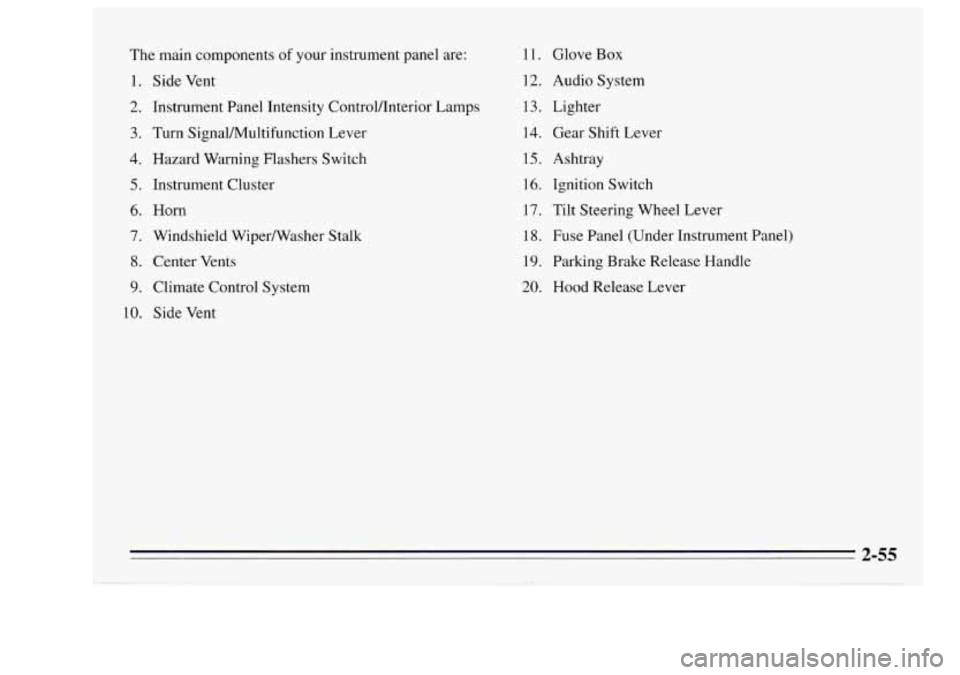
The main components of your instrument panel are:
1.
2.
3.
4.
5.
6.
7.
8.
9.
10.
Side Vent
Instrument Panel Intensity Controlflnterior Lamps
Turn SignaVMultifunction Lever
Hazard Warning Flashers Switch
Instrument Cluster
Horn
Windshield WiperNasher Stalk
Center Vents
Climate Control System
Side Vent 11.
Glove
Box
12. Audio System
13. Lighter
14. Gear Shift Lever
15. Ashtray
16. Ignition Switch
17. Tilt Steering Wheel Lever
18. Fuse Panel (Under Instrument Panel)
19. Parking Brake Release Handle
20. Hood Release Lever
2-55
Page 127 of 340
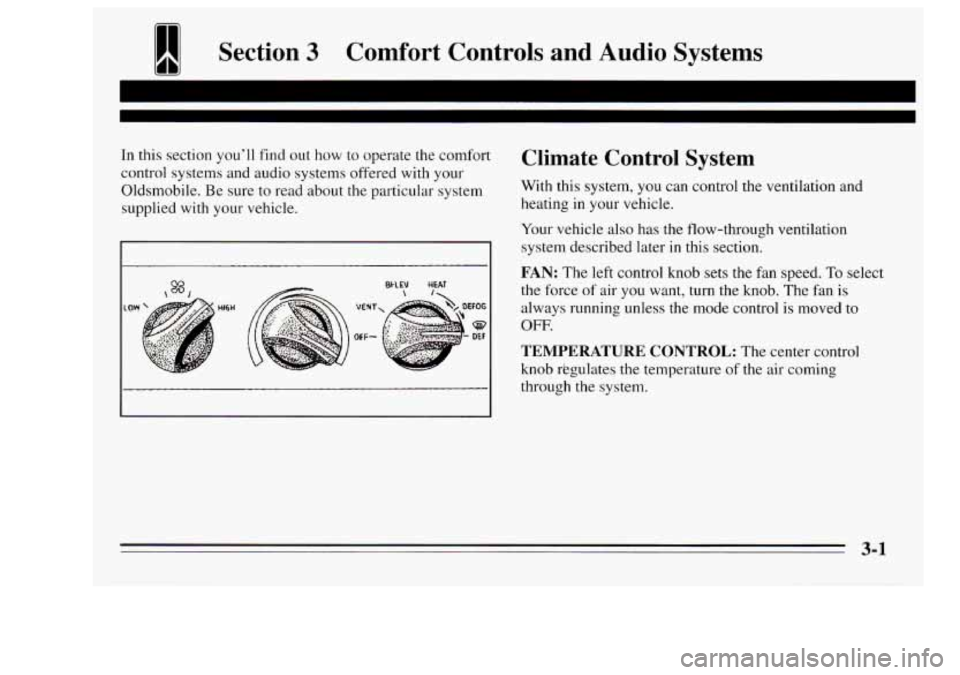
Section 3 Comfort Controls and Audio Systems
In this section you’ll find out how to operate the comfort
control systems and audio systems offered with your
Oldsmobile. Be sure to read about
the particular system
supplied with your vehicle.
I
Climate Control System
With this system, you can control the ventilation and
heating in your vehicle.
Your vehicle also has the flow-through ventilation
system described later in this section.
FAN: The left control knob sets the fan speed. To select
the force of air you want, turn the knob. The fan
is
always running unless the mode control is moved to
OFF.
TEMPERATURE CONTROL: The center control
knob rkgulates
the temperature of the air coming
through the system.
Page 129 of 340
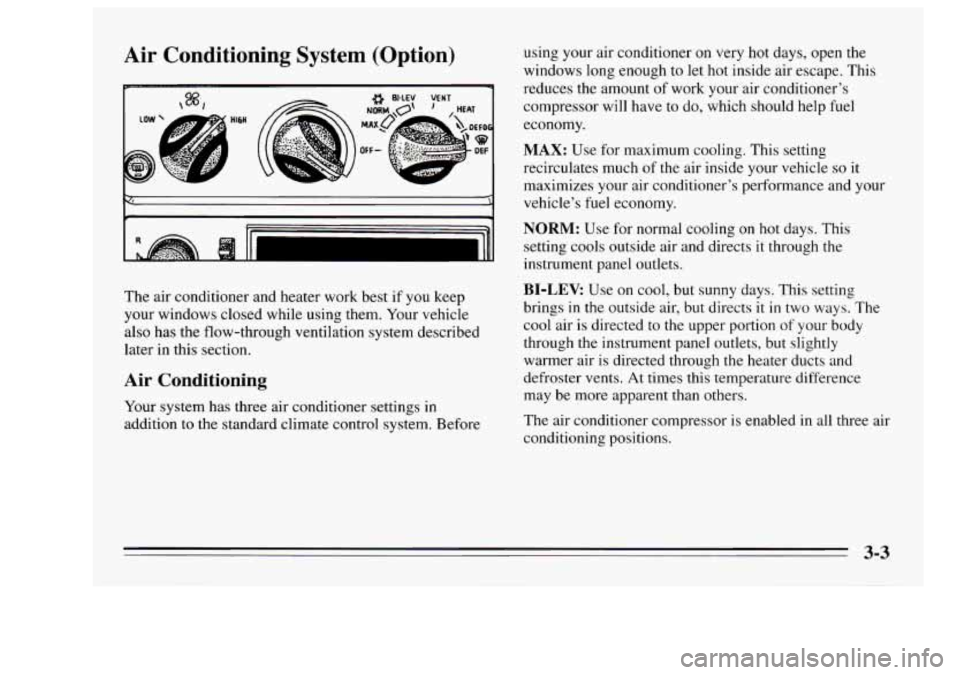
Air Conditioning System (Option)
The air conditioner and heater work best if you keep
your windows closed while using them. Your vehicle
also has the flow-through ventilation system described
later in this section.
Air Conditioning
Your system has three air conditioner settings in
addition to the standard climate control system. Before using
your air conditioner
on very hot days, open the
windows long enough to let hot inside air escape. This
reduces the amount of work your air conditioner's
compressor will have
to do, which should help fuel
economy.
MAX: Use for maximum cooling. This setting
recirculates much of the air inside your vehicle
so it
maximizes your air conditioner's performance and your
vehicle's fuel economy.
NORM: Use for normal cooling on hot days. This
setting cools outside air and directs it through the
instrument panel outlets.
BI-LEV: Use on cool, but sunny days. This setting
brings
in the outside air, but directs it in two ways. The
cool air
is directed to the upper portion of your body
through the instrument panel outlets, but slightly
warmer air is directed through the heater ducts and
defroster vents. At times this temperature difference
may be more apparent than others.
The air conditioner compressor is enabled in all three air
conditioning positions.
3-3
Page 248 of 340
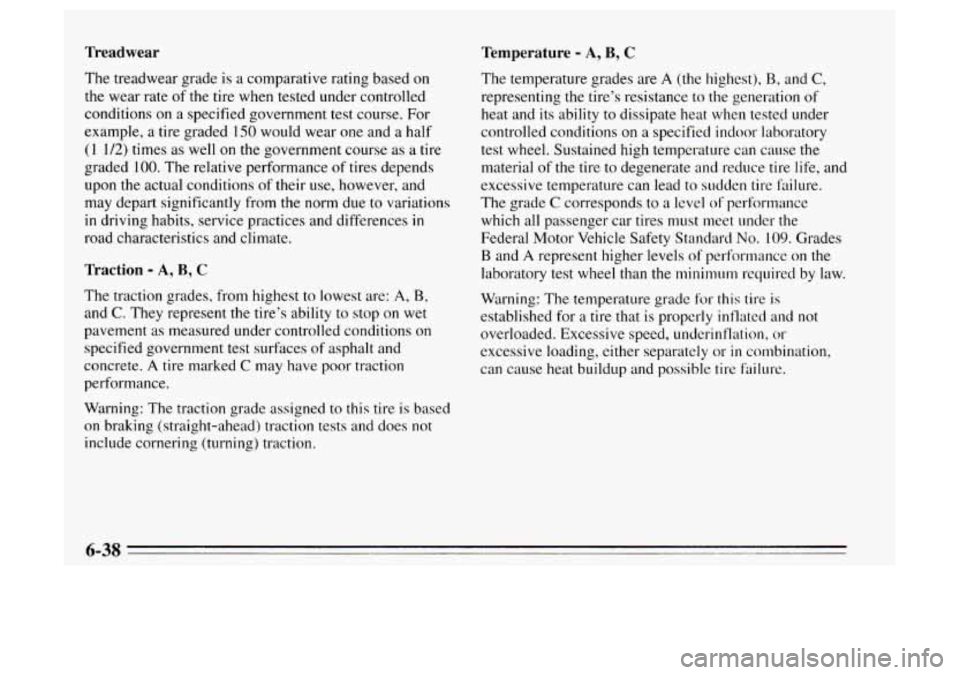
Treadwear Temperature - A, B, C
The treadwear grade is a comparative rating based on
the wear rate of the tire when tested under controlled
conditions on
a specified government test course. For
example, a tire graded
150 would wear one and a half
(1 1/2) times as well on the government course as a tire
graded 100. The relative performance
of tires depends
upon the actual conditions of their use, however, and
may depart significantly from the norm due
to variations
in driving habits, service practices and differences in
road characteristics and climate.
Traction - A, B, C
The traction grades, from highest to lowest are: A, B,
and C. They represent the tire’s ability to stop on wet
pavement as measured under controlled conditions on
specified government test surfaces of asphalt and
concrete.
A tire marked C may have poor traction
performance.
Warning: The traction grade assigned to this
tire is based
on braking (straight-ahead) traction tests and does not
include cornering (turning) traction. The
temperature grades are
A (the highest), B, and C,
representing the tire’s resistance to the generation of
heat and its ability to dissipate heat when tested under
controlled conditions on a specified indoor laboratory
test wheel. Sustained high temperature can cause the
material of the tire to degenerate and reduce tire life, and
excessive temperature can lead to sudden tire failure.
The grade
C corresponds to a level of performance
which all passenger car tires must meet under the
Federal Motor Vehicle Safety Standard
No. 109. Grades
B and A represent higher levels of performance on the
laboratory test wheel than the
ninimum required by law.
Warning:
The temperature grade for this tire is
established for a tire that is properly inflated and not
overloaded. Excessive speed, underinflation, or
excessive loading, either separately or
in combination,
can cause heat buildup and possible tire failure.
6-38
Page 329 of 340
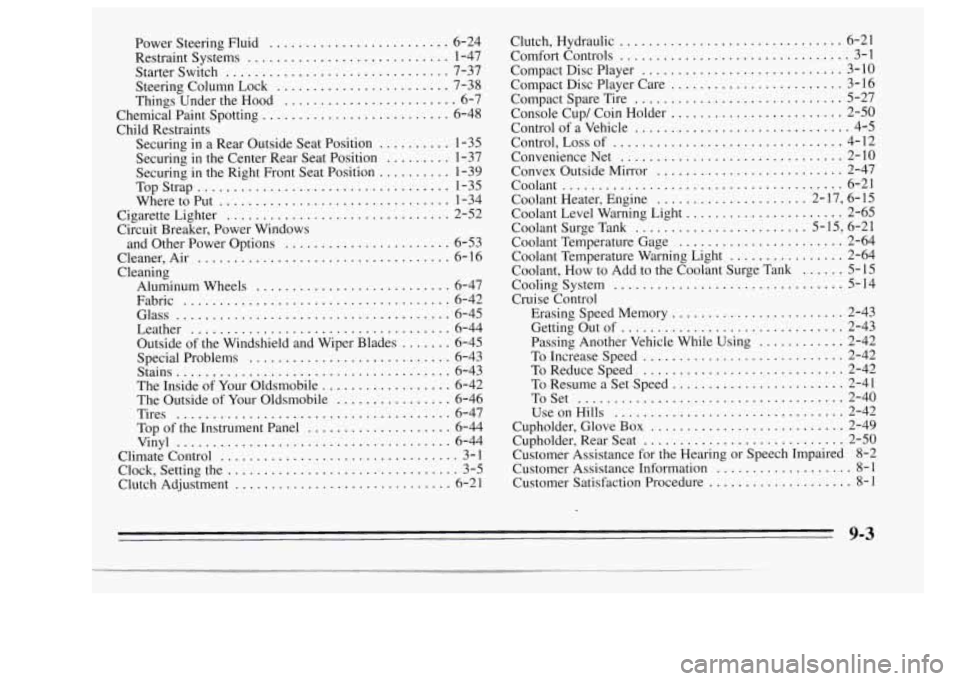
Power Steering Fluid ......................... 6-24
Restraint Systems
............................ 1-47
Starter Switch
............................... 7-37
Steering Column Lock
........................ 7-38
Things Under the Hood
........................ 6-7
Chemical Paint Spotting
.......................... 6-48
Child Restraints
Securing in a Rear Outside Seat Position
.......... 1-35
Securing in the Center Rear Seat Position
......... 1-37
Securing in the Right Front Seat Position
.......... 1-39
TopStrap
................................... 1-35
Cigarette Lighter
............................... 2-52
Circuit Breaker. Power Windows
and Other Power Options
....................... 6-53
WheretoPut
................................ 1-34
Cleaner. Air
................................... 6-16
Fabric
..................................... 6-42
Glass
...................................... 6-45
Leather
.................................... 6-44
Cleaning
Aluminum Wheels
........................... 6-47
Outside
of the Windshield and Wiper Blades ....... 6-45
Special Problems
............................ 6-43
Stains
...................................... 6-43
The Inside of Your Oldsmobile
.................. 6-42
The Outside
of Your Oldsmobile ................ 6-46
Tires
...................................... 6-47
Top
of the Instrument Panel .................... 6-44
Climate Control
................................. 3-1
Clock, Setting the
................................ 3-5
Clutch Adjustment .............................. 6-21
Vinyl
...................................... 6-44 Clutch.
Hydraulic
............................... 6-21
Comfort Controls
................................ 3-1
Compact Disc Player
............................ 3-10
Compact Disc Player Care
........................ 3-16
Compact Spare Tire
............................. 5-27
Console Cup/ Coin Holder
........................ 2-50
Control of a Vehicle
.............................. 4-5
Control. Loss of ................................ 4-12
Convenience Net
............................... 2-10
Convex Outside Mirror
.......................... 2-47
Coolant Heater. Engine
..................... 2- 17, 6- 15
Coolant Level Warning Light ...................... 2-65
Coolant Surge Tank
........................ 5- 15, 6-21
Coolant Temperature Gage
....................... 2-64
Coolant Temperature Warning Light
................ 2-64
Coolant. How to Add to the Coolant Surge Tank
...... 5-15
Cooling System ................................ 5-14
Cruise Control
Erasing Speed Memory
........................ 2-43
Getting Out
of ............................... 2-43
Passing Another Vehicle While Using
............ 2-42
To Increase Speed
............................ 2-42
To Resume a Set Speed
........................ 2-41
Coolant
....................................... 6-21
ToReduceSpeed
............................ 2-42
ToSet
..................................... 2-40
UseonHills
................................ 2-42
Cupholder. RearSeat
............................ 2-50
Cupholder, Glove
Box
........................... 2-49
Customer Assistance for the Hearing or Speech Impaired
8-2
Customer Assistance Information ................... 8-1
Customer Satisfaction Procedure
.................... 8-1
9-3